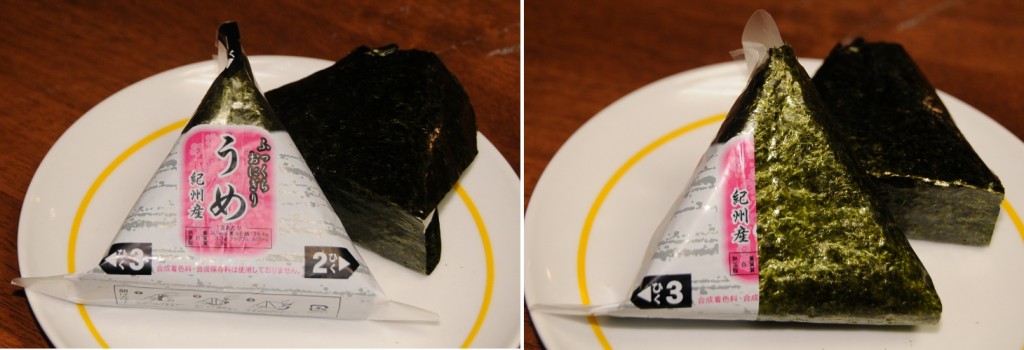Time to write about food again! One of the things I love about Japan is the great variety of cheap takeout. Many small restaurants provide takeout dishes if you don’t want to eat there, there are a number of sushi places that mostly cater to the takeout crowd – one in my neighbourhood has only a single table with two chairs so you can wait if you want anything extraordinary – and, of course, all the convenience stores have takeout dishes and a microwave for free use if you are extremely hurried.
My personal favourite takeout meal from the convenience store around the corner consists of various types of onigiri. They are nothing special, just rice balls with or without stuffing, about the size of a fist, mostly in triangular or oval shape, and often covered in seaweed. They are available in many flavours. The plain ones without stuffing can be only salted, or they are cooked with some red beans or other flavour and sprinkled with seaweed crumbs or black or white sesame. Sometimes they have a piece of fish on top, then they resemble an oversized piece of sushi (which is called nigiri sushi, by the way). Alternatively, onigiri can be stuffed with all sorts of things, from fish with or without mayonnaise, cooked beef or chicken, vegetables or different types of seaweed, to salty, pickled ume plums. The last type of filling is very interesting, for me it falls under “acquired taste”.
It is very easy to make onigiri at home, as they are only rice cooked with seasoning (different kinds are readily available) which is shaped and then cooled. Some people like to carefully fry the finished onigiri in oil, this is often done after a day or two when the rice has dried out too much to be tasty. 
The convenience store bought onigiri are mostly triangular and wrapped in nori seaweed. They have a very ingenious packaging, because if the nori is in contact with the rice for too long, it becomes soggy and unpleasant to eat. So, the packaging consists of two layers of plastic, one on the outside and one that lies between the rice and the nori, separating the two until the onigiri is eaten, so that the nori always tastes fresh and crispy. Unfortunately this does not show in the picture above. There is of course a special way of unwrapping those onigiri: First you tear the package from the top corner, all the way from front to back, and then you gently pull on the left and right corner of the package to remove it from the outside and underneath the nori. How to do this is conveniently described on the package with 1 – 2 – 3 steps, I find this quite funny.

Sorry, but you better not call the nori soggy and then unpleasant tasting because this still is the way mothers make onigiri for their children. Maybe it is an aquired taste.
I hope you don’t want to compare home-made onigiri and store bought ones. I since had the opportunity to try them both, and the homemade ones are a league of their own, soggy nori or not 😉